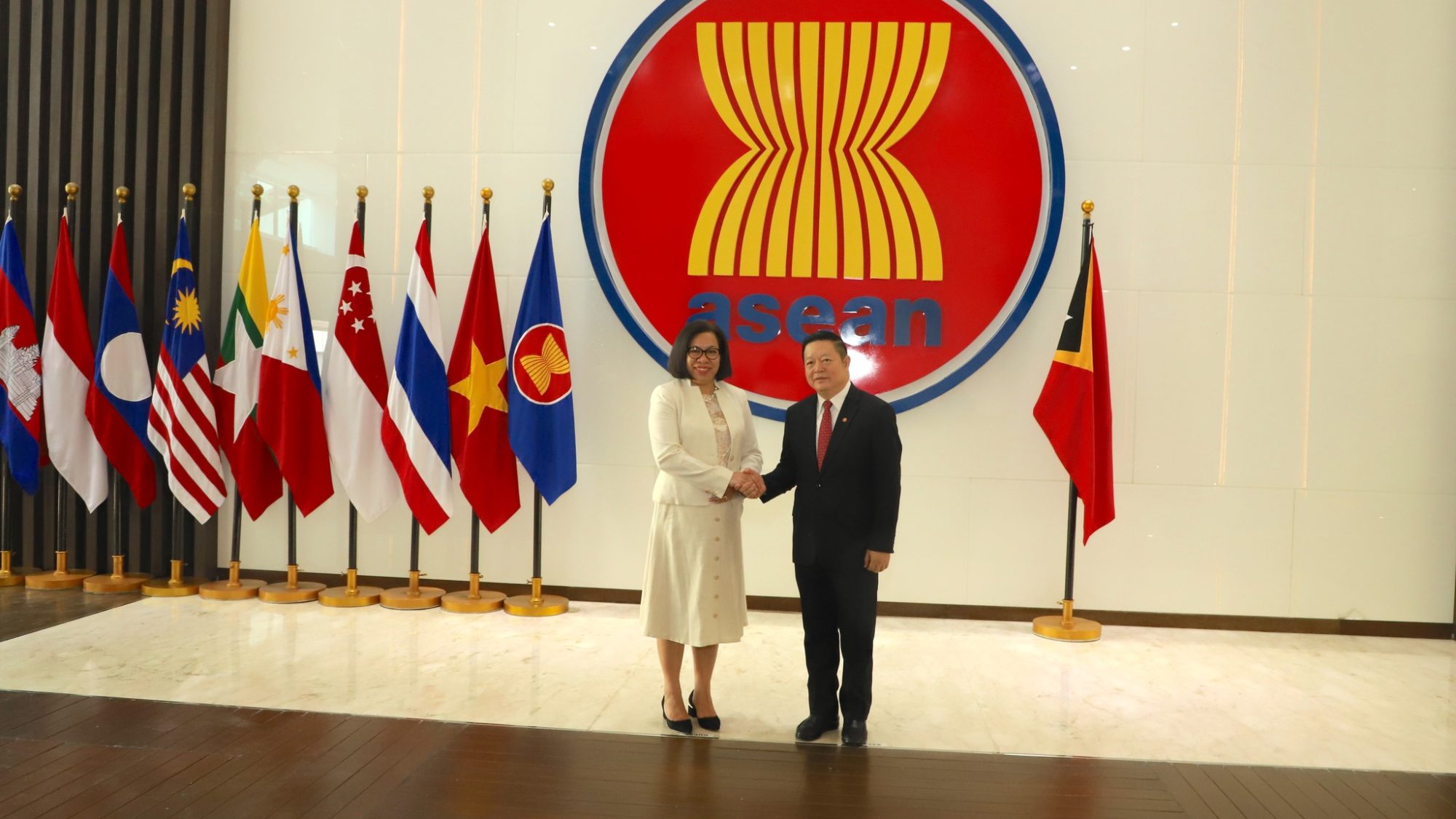
Title: Indo-Pacific Needs the Third Pole, ASEAN+1
The countries in Indo-Pacific are currently caught in an intensifying competition for regional influence between China and the United States. But it is impossible for them to choose between the two because they rely on both powers for economic and strategic reasons. As an alternative, Japan and ASEAN countries should unite to create ASEAN+1, a third pole that will diffuse tension between the two great powers.
The United States and China seem to be competing on every front in their recent disputes over the WHO, WTO, 5G, outer space sovereignty, and trade. The matter of regional security has been no exception. China has increased its territorial aggressions and military drills in East Asia, particularly since the beginning of the COVID-19 pandemic and its successful management of the outbreak. The United States has become firmer in its response to this aggression in both rhetoric and military action. Both powers are trying to win regional favor and influence by proposing support frameworks: China through the Belt and Road Initiative (BRI) and the United States through the Free and Open Indo-Pacific Framework (FOIP). China’s exponentially increasing aggression only proves the importance of the South China Sea as both a strategic buffer and an economic opportunity.
Getting caught in the crossfire between China and the United States is a major concern for Japan and the member countries of the Association of Southeast Asian Nations (ASEAN), who are closest to the region. They cannot afford to choose between China and the United States. They rely heavily on China economically and will need to continue to do so in the hope of an economic recovery post-pandemic. But simultaneously, China’s aggressive military and economic actions are potential threats to their territorial and economic stability. To deter China’s actions against them, they must rely upon the security umbrella of the United States.
A report by the Brookings Institution recommended that ASEAN establish a ‘minilateral’ cooperation with the United States and its allies while excluding China. But this is exactly what ASEAN ought to avoid. Both Japan and ASEAN need the cooperation of both China and the United States. The countries themselves seem to realize this. Just a day before meeting with Secretary of State Mike Pompeo, Japanese Prime Minister Yoshihide Suga expressed his eagerness “to build stable relationships with neighboring countries including China and Russia” indicating a desire to balance both sides of the relationship.
A Better Solution
In light of this, I propose ASEAN and Japan form ASEAN+1, a comprehensive regional security framework that provides a third pole apart from the polarities of China and the United States. The key to ASEAN+1 is to allow Japan to become more integrated into and take on a greater role as a de facto ASEAN member while respecting ASEAN Centrality, putting the two on equal footing. Its goal will be to enhance the security level of both ASEAN and Japan by acting together to avoid being torn between China and the United States.
True, ASEAN and Japan already have a strong economic and strategic partnership, particularly faced with China’s increasing aggression in the region. But China-US competition has heightened regional insecurity to a point that cannot be aptly handled by the current cooperation framework between Japan and ASEAN. Therefore, the two must work to build a stronger, formalized institution to tackle these new regional challenges.
One may argue that the region already has security frameworks such as the Asia Regional Forum and ASEAN+3 (Japan, China, and South Korea) and the Quadrilateral Security Partnership (QUAD, the US, Japan, Australia, and India), which may incorporate ASEAN members in the future. However, unlike ASEAN+1, none of them are independent from US-China great power competition and cannot provide a ‘third pole’ to mediate between the two powers.
ASEAN+1 can also solve ASEAN’s fundamental issue of institutional decay. ASEAN lacks integration due to its consensus-based decision making procedures among the widely divided members, which render ASEAN indecisive and undermines ‘ASEAN Centrality.’ Although there have been efforts to mitigate this problem, such as “the Initiative for ASEAN Integration (IAI)” launched two decades prior, the problem has remained. Japan has the resource capability and experience to bridge the gap between ASEAN countries and has already been working to resolve the issue. Knowing that the wide divide is primarily between the more developed and the less developed, Laos, Myanmar and Cambodia, Japan created the Japan-ASEAN Integration Fund (JAIF) in 2006 to close the financial and developmental gap within ASEAN. So far, Japan has dedicated more than 749 million USD to this fund. As ASEAN+1, Japan can join the IAI task force as a de-facto member to help distribute and coordinate development efforts rather than just providing funding from the outside. This could then help to further some of Japan’s ongoing efforts to boost ASEAN’s infrastructure, such as the ‘Connectivity Initiative.’ In this sense, ASEAN+1 would be a natural continuation of the ongoing projects and cooperation between Japan and ASEAN.
While sounding simple, the notion of ASEAN+1 has a slew of benefits for both Japan and the ASEAN countries. A deepening of institutional relations would enhance the political leverage of both ASEAN and Japan. A good example is ASEAN members’ commitments to China’s BRI projects. As ASEAN+1, Japan can provide hands-on advice on how to evaluate and assess each project, which will pressure China to increase rationality and transparency. Thus ASEAN+1 can protect its members from the so-called ‘debt trap.’
ASEAN+1’s primary mission to secure the openness and sovereignty of the South China Sea and the Indian Ocean would allow ASEAN and Japan to combine their resources and jointly protect their maritime interests. The sea is an integral part of the economy for both groups. Although Japan already has provided maritime security training and equipment such as patrol vessels and monitoring radar to ASEAN countries individually, ASEAN+1 can enhance their presence and influence as a unitary player. It can launch joint maritime patrols and training of maritime law enforcement. It could also institute a maritime security center to administrate such activities, exchange information, and coordinate surveillance activities.
ASEAN+1 even has the potential to go as far as to establish a formal ASEAN-Japan immigration program. Japan suffers from a labor force shortage due to an aging society. Further, without sufficient foreign workers and exposure to globalization values, Japan’s competitiveness has declined, particularly in business efficiency. Meanwhile, ASEAN has an abundant young labor force looking for improved job opportunities. There is a sufficient amount of demand and supply. The Abe administration already recognized this and launched a ‘very open’ scheme to host foreign workers. An ASEAN-Japan immigration agreement would not only be a continuation of that, but it would also add a geographical component to the institution of ASEAN+1, which would further manifest it as a legitimate institution. It would also boost the ASEAN+1 economy and make Japan’s economy resilient in the long term.
ASEAN and Japan share similar regional interests and have much to gain by integrating their relationship into ASEAN+1. By doing this, ASEAN+1 would become the third pole of Asia next to China and the United States, not to stand against the two, but to reduce their competition by remaining neutral and thus increasing the chances of cooperation.
But would the United States allow its allies in Asia to create another pole? Although it may not want to, it must, because the United States cannot afford to hand its allies to China. Leading US foreign policy experts stated about Indo-Pacific, “Ceding the world’s most dynamic region to China would do long-term harm to American workers and businesses.” But US policy that pressures Asian nations to choose a side will only drive Asia further away. Instead, ASEAN+1 can coordinate U.S. interests with those of all Asian countries, including China, to maintain peace.
No one predicted how the world would look in 2020. The world is changing much faster than before. Traditional approaches to national security must be reconsidered. Japan and the ASEAN countries need to be creative in protecting their national interests. ASEAN+1 can meet this call of our time.
. . .
Fumiko Sasaki, Ph.D. is a faculty member of the School of International and Public Affairs, Columbia University. She is also a visiting scholar at the Reischauer Center at School of Advanced International Studies, Johns Hopkins University.
Image Credit: Ministry of Foreign Affairs and Cooperation of Timor-Leste, Public domain, via Wikimedia Commons
Recommended Articles

For many in the Global South, the ‘American Peace’ or Pax Americana is a mirage amid a world of war, economic hardship, forced migration, environmental calamity, and political repression while…

The United Nations is scheduled to host its third meeting of international envoys to Afghanistan in Doha on June 30, 2024. This meeting aims to discuss and address significant…

Qatar plays a crucial role in mediating conflicts in the Middle East region. Its engagement in negotiations with diverse stakeholders–including countries like Lebanon, Sudan, and Libya and non-state actors such…